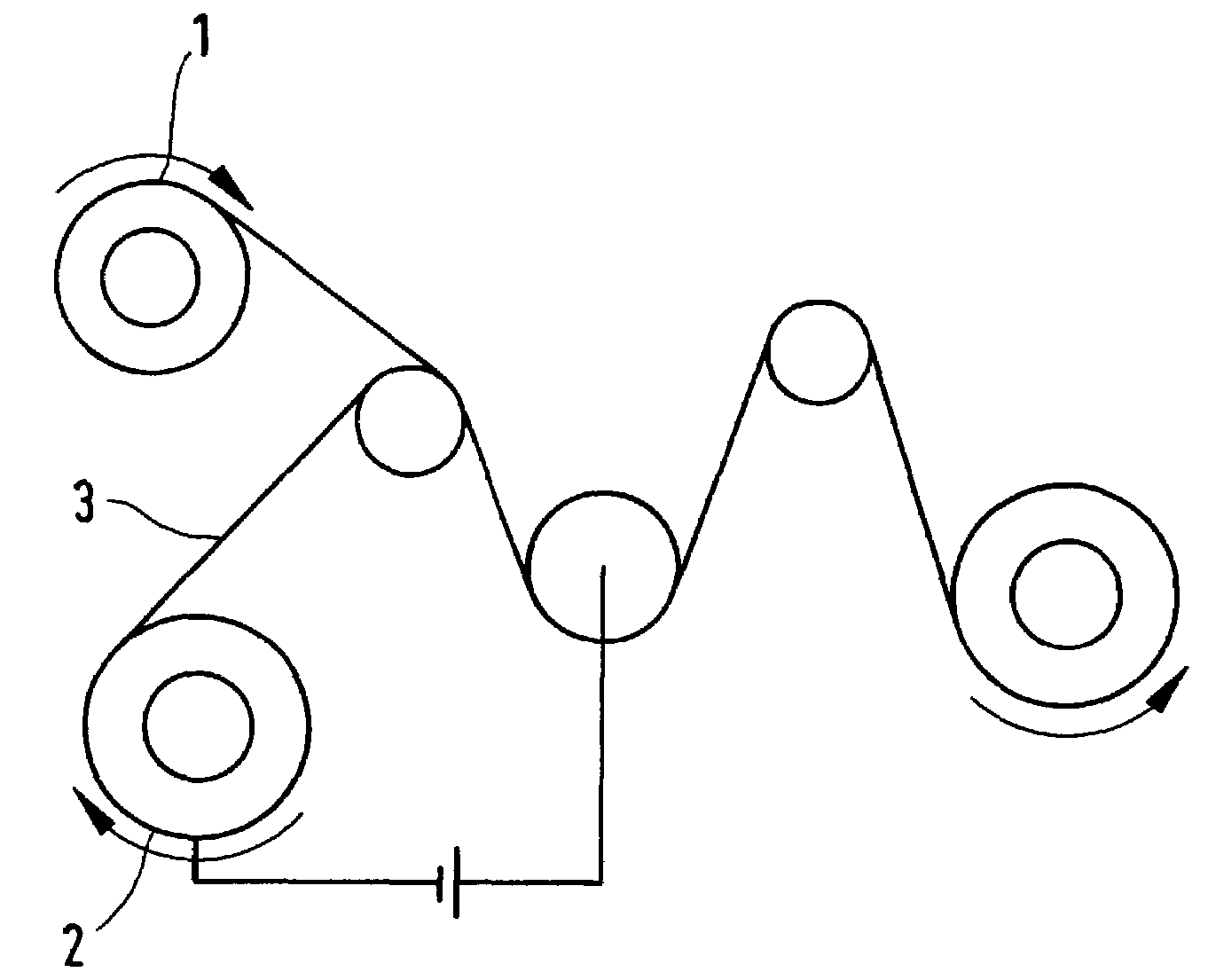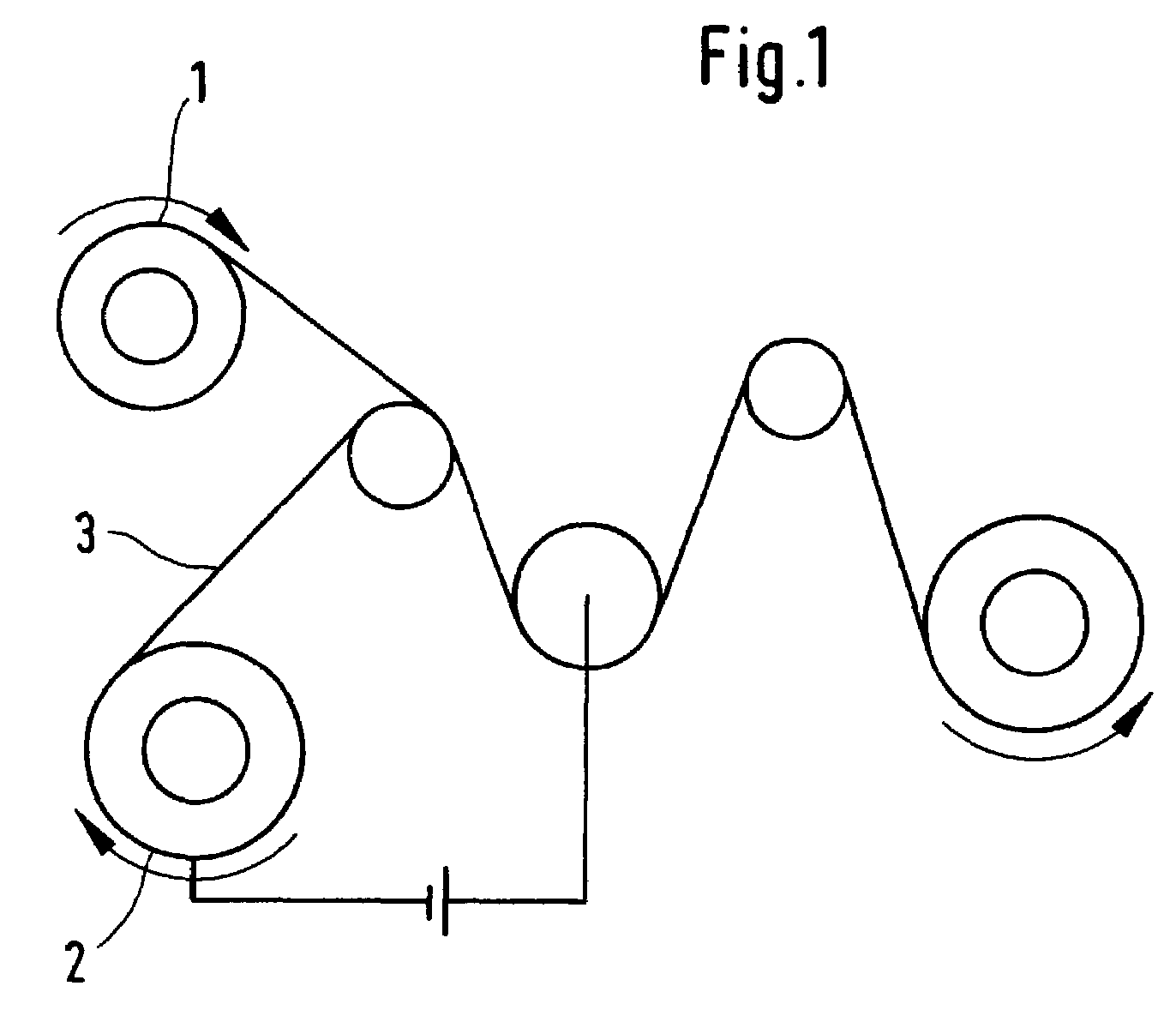Transparent film made from PET and PEN with UV protection, process for producing the film, and use of the film in packaging with extended shelf life
- Summary
- Abstract
- Description
- Claims
- Application Information
AI Technical Summary
Benefits of technology
Problems solved by technology
Method used
Image
Examples
example 1
[0075]A transparent film of thickness 23 μm is produced.
[0076]Raw materials:
[0077]
R1:RT49 PET (KoSa, Offenbach, Germany),46% by weightSV = 800R2:PET / PEN film regrind with 10% by weight PEN50% by weightcontent, SV = 700, IPA content = 4% by weight,comprising 500 ppm of Sylysia 320 and 500ppm of Aerosil TT600 (Degussa)R3:PET, SV = 800, comprising 4% by weight10 000 ppm of Sylysia 320 and 15 000 ppm ofAerosil TT600 (Degussa, Germany)
Oxygen Barrier=50{cm3 / (m2·d·bar)}·{23 μm / 12 μm}
[0078]Shelf life rise in % compared with a similar composite using RNK 23 film (Mitsubishi Polyester Film GmbH, Wiesbaden, Germany):
[0079]
Composite A:50%Composite B:55%Composite C:35%
example 2
[0080]A transparent film of thickness 12 μm is produced.
[0081]Raw materials (% by weight data based on the 60% by weight content of virgin raw material; the film comprises 40% by weight of self-regrind):
[0082]
R1:RT49 PET, SV = 80085% by weightR3:PET from KoSa, SV = 800, comprising 10 000 5% by weightppm of Sylysia 320 and 15 000 ppm of AerosilTT600 (Degussa, Germany), and 0.2% byweight of anthraquinone dye (Sudan Blue 2,BASF, Ludwigshafen, Germany)R4:100% by weight of PEN (KoSa, Offenbach,10% by weightGermany), SV = 650
Oxygen Barrier=93{cm3 / (m2·d·bar)}·{12 μm / 12 μm}
[0083]Shelf life rise in % compared with a similar composite using RNK 12 film (Mitsubishi Polyester Film GmbH, Wiesbaden, Germany):
[0084]
Composite A:102%Composite B: 98%Composite C: 60%Yellowness Index = 1
example 3
[0085]A transparent film of thickness 8 μm is produced.
[0086]Raw materials (% by weight data based on the 60% by weight content of virgin raw material; the film comprises 40% by weight of self-regrind):
[0087]
R1:RT49 PET, SV = 80080% by weightR3:PET, SV = 800, comprising 6% by weight10 000 ppm of Sylysia 320 and 15 000 ppm ofAerosil TT600 (Degussa, Germany)R4:100% by weight of PEN (KoSa),14% by weightSV = 650
Oxygen Barrier=137{cm3 / (m2·d·bar)}·{8 μm / 12 μm}
[0088]Shelf life rise in % compared with a similar composite using RN 8 film (Mitsubishi Polyester Film GmbH, Wiesbaden, Germany):
[0089]
Composite A:114%Composite B: 99%Composite C: 75%
PUM
| Property | Measurement | Unit |
|---|---|---|
| Fraction | aaaaa | aaaaa |
| Fraction | aaaaa | aaaaa |
| Percent by mass | aaaaa | aaaaa |
Abstract
Description
Claims
Application Information
 Login to View More
Login to View More - R&D
- Intellectual Property
- Life Sciences
- Materials
- Tech Scout
- Unparalleled Data Quality
- Higher Quality Content
- 60% Fewer Hallucinations
Browse by: Latest US Patents, China's latest patents, Technical Efficacy Thesaurus, Application Domain, Technology Topic, Popular Technical Reports.
© 2025 PatSnap. All rights reserved.Legal|Privacy policy|Modern Slavery Act Transparency Statement|Sitemap|About US| Contact US: help@patsnap.com


